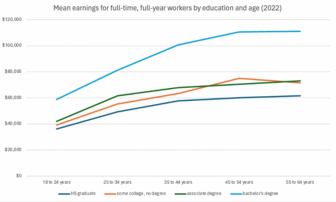
Governor Whitmer with lots of bi-partisan and business community support has established the goal of 60 percent of Michigan adults having a post- secondary credential by 2030. The Lumina Foundation––which has been at the center of the national effort to get to 60 percent––calculates that in 2017 45 percent of 25-64 year old Michiganders had a high-quality certificate, Associates Degree or Bachelors Degree. Getting from 45 percent to 60 percent will be quite difficult.
Before we explore the barriers to getting to 60 percent, it is worth noting that there are not anywhere near 60 percent of Michigan jobs that require a post-secondary credential. In 2017 51 percent of Michigan jobs were in occupations that require no more than a high school degree. The state’s 2016-2026 projections are that annually over the next decade 58 percent of job openings will be in occupations that require no more than a high school degree.
Another caution worth noting is that lots of non-degree credentials don’t lead to family-sustaining wages and benefits. See my Cosmetology schools and crushing student loans post as an example. So defining high-quality certificates is vital. One unintended negative consequence of the 60 percent goal could be that we end up pushing people into getting credentials for lower-wage jobs. Not progress.
A final cautionary note, the 60 percent goal seems to equate high-quality certificates, Associates Degrees and Bachelors Degrees. They are in no way equal. As my colleague Sarah Szurpicki detailed in her last post 77 percent of Michigan employment in occupations with a median wage of more than $61,000 are in occupations that require a four-year degree. The reality is than for individuals, households and states and regions four-year degrees are, by far, the most important to achieving economic well being.
With those cautions noted, what follow are the lessons we have learned about the most impactful levers to substantially improve post-secondary credential attainment. The problem is most are really difficult to implement. If you take them off the table because they are hard you end up not moving the needle much.
The main lessons we have learned are that the main reasons of low post-secondary credential rates are both (1) under funding of both education institutions and meeting the whole child needs of students and (2) that K-16 institutions, by and large, are not designed for mass post-secondary completion. That if you don’t do the hard work to deal with both you cannot get from the 45 percent post-secondary credential attainment today to 60 percent by 2030.
In a terrific Dome Magazine column entitled Michigan’s Community Colleges are Failing our Kids Chad Selweski details that reality. He writes:
A bipartisan consensus has emerged among state officials that community colleges should play a major role in boosting the Michigan economy by bridging the “skills gap” between high school graduates and college grads. …
Yet, few elected officials seem willing to acknowledge that Michigan’s community colleges fall far short in offering the kind of schooling that leads to good jobs with good pay. Community colleges are supposed to provide a gateway to middle class careers, producing graduates ranging from welders to dental hygienists.
In fact, all of the state’s public community colleges rank below 300 or more schools nationwide, based on basic measurements of quality education. In particular, some Michigan community colleges have graduation rates below 20 or 25 percent. …
Mott Community College in Flint is ranked best in Michigan. Its overall, national rank? 319th. These ratings are based on research conducted by Wallet Hub, a well-recognized website that benefits consumers by compiling data and ranking companies or government institutions.
If you don’t deal with low completion rates at community college and at non-selective universities it is almost certain you cannot get to 60 percent. The good news is we are not starting from scratch. As we explored previously, Redesigning America’s Community Colleges lays out the playbook for substantially improving completion rates at community colleges and I would argue non-selective universities.
There is an upcoming book called the B.A. Breakthrough which identifies best practices in high-poverty high schools that has led to much higher post–secondary completion rates. Michigan Future published a playbook that deals with many of these same best practice lessons. To get to 60 percent we need high schools (probably all K-16 schools) to be explicitly designed for post-secondary success of all students.
The challenge is all these playbooks involve fundamental redesign of education institutions. Which is really hard and not cheap. Each book calls for transformative change in how schools are organized, what they teach, how they teach, increased and better counseling and increased and better student supports.
Initiatives like free community college tuition and Tennessee Reconnect––both which reduce the cost of going to college somewhat––only deal with a small part of the reason why completion rates are so low. As we have explored previously tuition––particularly at community colleges––is nowhere near the biggest hurdle to earning a post-secondary credential.
If Michigan is serious about getting to a 60 percent post-secondary credential rate by 2030 what is needed is a substantial increase in state funding for education from birth through college and a substantial increase in state funding to deal with the life challenges that students bring with them to school once again from birth through college combined with a fundamental redesign of K-16 education institutions around the mission of post-secondary completion. Anything short of all three will almost certainly leave us in 2030 and beyond far short of 60 percent.







